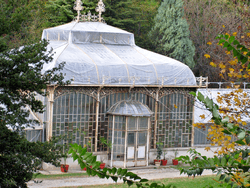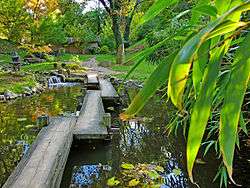Jevremovac
| Jevremovac Јевремовац | |
|---|---|
| Urban neighbourhood | |
 Greenhouse in the Botanical Garden Jevremovac, Belgrade | |
 Jevremovac Location within Belgrade | |
| Coordinates: 44°48′56.9″N 20°28′23.6″E / 44.815806°N 20.473222°ECoordinates: 44°48′56.9″N 20°28′23.6″E / 44.815806°N 20.473222°E | |
| Country |
|
| Region | Belgrade |
| Municipality | Stari Grad |
| Time zone | UTC+1 (CET) |
| • Summer (DST) | UTC+2 (CEST) |
| Area code | +381(0)11 |
| Car plates | BG |
Jevremovac Botanical Garden (Serbian Cyrillic: Ботаничка башта Јевремовац) is the botanical garden of the University of Belgrade and also an urban neighborhood of Belgrade, the capital of Serbia. It is located in Belgrade's municipality of Stari Grad and is an administered by the University of Belgrade's Biology School.
It has been declared a natural monument in 1995 and cultural monument in 2007.[1]
Location

Jevremovac is located in the westernmost part of the Palilula neighborhood, but after the changes of the municipal administrative borders in 1952, 1955 and 1957, it didn't become part of the municipality of Palilula but of Stari Grad. It is bounded by the Boulevard of despot Stefan and the streets of Takovska, Dalmatinska, Palmotićeva and Vojvode Dobrnjca.
The First Town Hospital, built in 1868, the first building purposely to serve as a hospital in Belgrade, is located in the neighborhood.
History

The botanical garden was founded in 1874 by the decree of the Ministry of Education of the Kingdom of Serbia, at the suggestion of Josif Pančić, famous botanist who also became its first manager. Original lot assigned to Pančić was on the bank of the Danube, in the neighborhood of Dorćol. Lots were abandoned by the ethnic Turks who left Belgrade after Turkish military garrison left the city, too, in 1867. City donated 1,400 ducats and Pančić arranged it, bit by bit. Terrain was adapted, and an embankment on the Danube was constructed. Pančić was pleased that the lot was in the vicinity of the downtown and the Kalemegdan Park, so that Belgraders can visit the garden with ease. The lot was parceled into several separate garden areas, a house for the gardener was built and the garden was officially opened in 1880. However, closeness of the garden to the Danube didn’t bode well for the development of the garden due to the flooding, despite the embankment. Pančić applied for another patch of land, but died in 1888. One month after his death, in October 1888, major flood destroyed almost everything Pančić planted. A year later, in 1889, even bigger flood inundated the remnants of the garden under a water one meter deep and destroyed everything that survived from the previous flood. Only some specimen, transferred to the garden of the Red Cross, survived. The garden became unusable.[2]
In Pančić’s honor, in 1889, king Milan Obrenović donated the estate (former orchard, inherited from his grandfather Jevrem Obrenović) to the Great School in Belgrade for the purpose of the construction of new botanical garden, provided that it be named "Jevremovac" (Serbian for "Jevrem's garden"), after his grandfather.[1] It exists to this day at the same location and under the same name and gave its name to the small surrounding neighborhood. Apart from its founder, Josif Pančić, very important for the development and growth of Jevremovac was its longtime manager (1906–34), Nedeljko Košanin under whose supervision botanical garden lived its 'golden age'. Present manager (2011) is prof. Petar Marin.
After World War II, new Communist authorities suppressed public usage of word Jevremovac, so it was simply known as "botanical garden" until the 1990s when Jevremovac came into common usage again. Also, arboretum was very neglected for decades and only recently began its partial renovation and beautification but Jevremovac soon became popular again and today, with 60,000 visitors a year, it is the second most visited natural monument in Serbia, after the mountain and national park Kopaonik.
Arboretum
The arboretum spreads over the area of 5 ha (12 acres) of open space and hosts 2,500 different plant species.[1] That includes over 250 species of trees and bushes including local, European and exotic plants. The total plant population now includes about 500 trees, bushes and herbaceous plants. Curiosity is a 150 years old oak Quercus trojana, believed to be a remnant of the vast oak woods common in this area. The oak itself is declared a natural monument.[1] Besides the open space, the arboretum also includes a greenhouse and the Institute of Botany's premises (administrative building, herbarium, library, lecture hall and laboratories). In front of the administrative building, a bust of the former manager Nedeljko Košanin was erected in 2006, celebrating 100 years of his appointment.
Parts of the arboretum are European garden and a Japanese garden, which was opened on 18 May 2004. The Japanese garden is created by Vera and Mihailo Grbić, landscape architects, and covers an area of 20 ares (22,000 square feet). European garden opened in 2006.[3]
The arboretum is open to visitors from May 1 to November 1 (09.00 a.m. – 07.00 p.m.).
Greenhouse
The greenhouse, built in 1892, covers an area of 500 m². At the time of its construction, it was one of the biggest and most beautiful greenhouses in this part of Europe. Over 1,000 species of tropical and sub-tropical plants are being nursed, including Canary Island Date Palm, European Fan Palm, and Peruvian cactus (Cereus peruvianus). The greenhouse is protected by the law for its architectural values. It was reconstructed in 1970[1] After partially collapsing in June 2005,[3] it was thoroughly reconstructed, that is, completely deconstructed and then built again, from 2012 to 3 October 2014.[4]
Herbarium
The herbarium, founded in 1860 and named after Josif Pančić, accommodates rich collections of plants originating from the Balkan peninsula and the rest of Europe containing around 120,000 herbarium sheets and over 300,000 dried specimens. It includes 16,000 sheets originally gathered by Pančić himself and specimens of some species which are extinct today.[1]
Library
The library is one of the oldest and the largest in this part of the world. It was founded in 1853 at the Belgrade Lyceum, where Pančić was a professor at the time. Apart from 200 scientific and professional magazines it also accommodates over 6,000 books, including Pliny the Elder’s Natural History, printed in 1562.[1]
Underground
During one of the reconstructions of the administrative building, two underground rooms with oval-shaped ceilings were accidentally discovered when a wall collapsed. They are assumed to be part of Belgrade’s lagums, vast web of underground corridors which spread beneath the surface of the city. As the temperature, even at the highest, never goes over 20 Celsius, it was used as a huge refrigerator where food and wine were cooled and preserved for the royal court, which is why they are called “King’s ice-cellars”. They cover 80 m2 (860 sq ft) and have a draining well at the center which drained the water from melted ice. Ice itself was brought during the cold winters when the Danube would freeze. Food was kept in the layers of ice and straw. Due to the high humidity and moisture, electricity can’t be introduced, so they are not opened for public.
Another lagum is close to the greenhouse. During the both World Wars, it was used as a shelter, but today is also inaccessible because it is flooded by the underground water. During the creation of the Japanese garden, a flow of underground water was discovered near lagum at the depth of 92 meters. Water is of an excellent quality and is used for watering plants in the garden and for filling artificial ponds.[1]
In popular culture
Jevremovac is also a place where exhibitions, concerts, theatre shows and fashion shows are held. Movies, which used the settings of the garden include We Are Not Angels (1992), Obituary for Escobar (2008) and Montevideo, God Bless You! (2010), while their music videos shot here Leo Martin and Legende.[1]
References
- 1 2 3 4 5 6 7 8 9 Branka Vasiljević (23 September 2012), "Jevremovac – istorija prirode i društva", Politika (in Serbian)
- ↑ Vojislav Gledić (29 April 2014), "Josif Pančić - 200 godina od rođenja", Politika (in Serbian)
- 1 2 D.Vukotić (28 October 2008), "Novo lice Jevremovca", Politika (in Serbian)
- ↑ M.Kosanović (2 October 2014). "Nakon dve godine rekonstrukcije: Sutra svečano otvaranje Botaničke bašte "Jevremovac"" (in Serbian). Blic.
